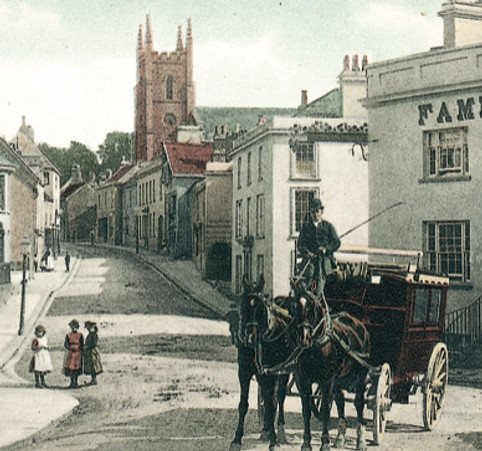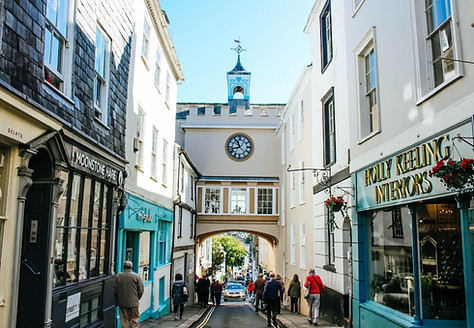
18th and 19th century Totnes with Bridgetown
In the 18th century, the cloth trade began to falter and Totnes had to rely more on its position as the market town of a rich agricultural region, and as a river trading point, to survive.
In 1720, Daniel Defoe visited Totnes and stayed at the Royal Seven Stars which had been built in about 1680. Defoe observed that Totnes was a very good town, with more gentlemen than traders, a sign that middle-class families from other parts of the country were moving there.
By the 1800s, Totnes was growing rapidly. In 1828, a new bridge was opened which led to the development of Bridgetown by the Duke of Somerset and, in 1834, Bridgetown was brought into the borough. The Duke was very active in Totnes, constructing quays and warehouses along the river and building the Seymour Hotel and the Church of St James (now St John’s). Much of the property in Totnes, as well as the castle ruins, remains in the ownership of the Seymour family.

Ancient history
According to legend, Brutus of Troy first stepped foot in Britain on the bank of the River Dart, strode up what is now Totnes High Street, put his foot on a convenient large stone he found there and declared "Here I stand and here I rest and this town shall be called Totnes". The stone is still there.
In 907AD, Alfred the Great’s eldest son, Edward, built a small settlement here to provide a place of safety in the event of a Viking invasion. At low tide an ancient trackway, the most important route through Devon, could be crossed by means of a ford across the River Dart and so the settlement also became a trading point. As the Viking threat receded, Totnes became a town for merchants rather than soldiers and several large houses were built.


Medieval and Tudors
Following the Norman Conquest, William the Conqueror bestowed Totnes and a hundred Devon manors on a favoured Breton by the name of Judhael, who built a motte and bailey castle across the town walls, and also a priory, which he eventually gave to the church.
However, Judhael fell out of favour with the king and eventually lost his lands. The town was in danger of decline until the people of Totnes took matters into their own hands and set about electing their own officials and, in following years, worked hard to develop their cloth trade. The town became so rich and successful that King John granted it a royal charter in 1206, making it only the second town in Britain to receive/buy this honour. This charter meant that the town was free to make its own laws and merchants also obtained the right to set up their own guild, which was an enormous boon to their trading position. The original guildhall on the High Street, the Gydallia of Tottas, was built at this time.
By the 15th century Totnes had become a leader in the cloth trade and the second-richest town in Devon. There was also a boom in Devon tin mining and much of this was exported from Totnes. It was at this time that the prosperity of the town resulted in the re-building of St Mary’s Church and the castle became the property of the Duke of Somerset.
In 1624, the new Guildhall was converted into a magistrate's court. Soldiers were billeted here during the English Civil War and Oliver Cromwell visited for discussions with the general and parliamentary commander-in-chief, Thomas Fairfax. Until 1887, the Guildhall was also used as the town prison, with the addition of prison cells. Some of the cells are now occupied by town council officers and the town council still sits around the very table where Cromwell once talked tactics.
Totnes today
By the start of the twentieth century Totnes had lost its eminence as a market centre and it looked as though the town was once again in danger of falling on hard times. Rescue was at hand in various guises.
Firstly, in commercial terms, a Wiltshire bacon factory - C and T Harris Ltd - decided to buy pigs in South Devon and set up a bacon factory in Totnes which created jobs for more than 300 people. Cow & Gate established a dairy near Totnes railway station before the Second World War and this was extended later to employ some 250 people. Down at the river, the timber yards of Messrs Reeves imported shiploads of timber from the Baltic countries, making use of the River Dart, as in days gone by, for commercial purposes.
Most of this industry has now gone. The bacon factory is now Morrisons supermarket, the dairy site is being developed into housing and the timber yards have turned into luxury homes and possibly another retirement village.
These days Totnes relies on its heritage, its beautiful setting and its fame as the original Transition Town to attract tourists. It is also helped by its proximity to Dartington estate, which in 1925 was bought by Dorothy and Leonard Elmhirst and became the famous Dartington Experiment. The Elmhirsts set up farming, forestry and educational projects, restored the beautiful 12th century Dartington Hall and in so doing became a magnet for artists, architects, writers, philosophers and musicians from around the world, creating an exceptional centre for creative activity. Today the Dartington Hall Trust manages the estate and although the Dartington Arts College has moved to Falmouth, the estate is still a focal point for enterprise and creativity, specifically around the Transition Town initiative, which began here and which has become a global movement.
Totnes benefits enormously from an influx of people from around the world, who come here to embrace its sustainable ethos. Many of these people stay and contribute to the rich life of the town. We are, at the beginning of the 21st century, a small, rural, market town, situated fortuitously between moor and shore, full of enterprising, ecological warriors, farmers, small business owners and increasingly, the well-heeled, retirees who keep our economy functioning. There are few places in the country to match Totnes.


